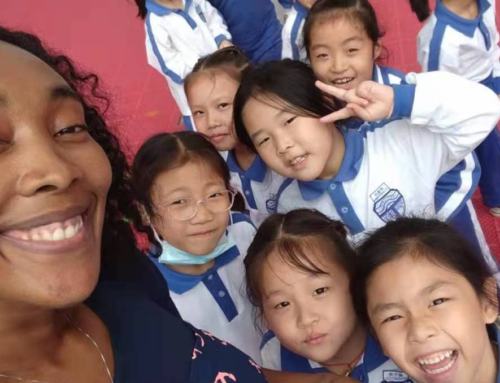When a fellow expat advised me to use Chinese words in my classes, I was hesitant. It just didn’t make sense to me. Why would I speak Chinese in my English class? Especially since one of my classroom rules was “English only!”
My friend’s idea ended up being useful, though.

Why? Because my students realized that they weren’t the only ones learning a second language. I was learning, too. Throwing in a Chinese phrase every now and then broke down the barrier between students and teacher. Although I was definitely still in charge, they knew that we were all language learners. Slowly but surely, I noticed more children summoning the courage to raise their hands in class.
The icing on the cake was that in my primary school classes, using Mandarin clarified misunderstandings.
Grade 1 students not only had almost zero English knowledge, but they also had no experience being students yet. Some of them became flustered when called on to answer a question, and most of them were intimidated because I was the first foreigner they had ever seen.
As a result, sometimes their brains froze when I spoke to them in English. Yes, this problem was common in my primary school classes, but I also knew several people who struggled with this issue in their classrooms full of teenagers. If we clarified in Chinese, students were more likely to relax and give their best effort.
Here are a few basic Mandarin phrases to try out in your classroom.
1. “Gěi wǒ.”
“Gěi wǒ” translates to “Give it to me.”
I used this phrase when my students were distracted in class. If they were reading a book, playing a game, or drawing a picture, I scolded them. Some students resisted when I wanted them to give me their book or picture, but once I said, “Gěi wǒ,” they usually relented and handed it over.

2. “Duì.”
“Duì” is the Mandarin word for “Yes” or “Correct.” It’s pronounced “dway.”
I used this word most often when calling on students in class. In classes of over 50 children, learning everyone’s Chinese name was difficult. All the kids had English names, but the young ones occasionally forgot their English names. As a result, I often just pointed to students to call on them for answers.
Students were often confused as to whether I was pointing to them or to the person behind them.
If I called on a child and they pointed at themselves in confusion, I said, “Duì!” to let them know that yes, I was pointing to them. This one word quickly moved the class along. If I had said, “Yes!” they would have spent time trying to process the English word I had just said.
3. “Bùshì …”
“Bùshì …” means “It’s not …”
This term is helpful when kids are learning vocabulary words. During a typical class period, I showed a picture and asked for the corresponding English word. If I showed a picture of a T-shirt and a child answered, “jacket,” I would say, “Bùshì ‘jacket.’” Then they knew to try a different word.
4. “Bù kě yǐ.”
I used this phrase when disciplining children, because “Bù kě yǐ” means “May not.” When a teacher says these words to a child, it translates to “You’re not allowed to do that.”
When a child hit another kid or looked on their neighbor’s homework, I said, “Bù kě yǐ!” This expression had a much stronger effect than saying, “No!” or “Stop!”

5. “Hěn hǎo!”
This is an encouraging term, translating to, “Very good!”
It’s important to encourage your students when they do well. While I praised them in English, I occasionally threw in a Chinese term of encouragement as well, just to make sure they understood that I was proud of them.

















Leave A Comment